After securing Spain Scipio, being an ardent patriot, sought to end the war with total victory rather than simply seeking terms as most of the war-weary senate desired. With Hannibal still in Italy with a veteran army Scipio proposed an invasion of Africa to end the war. From Livy, this is Scipio’s plea to the senate:
“Italy has suffered long; let her for a while have rest. It is Africa’s turn to be devastated by fire and sword. It is time a Roman army threatened the gates of Carthage, rather than that we should again see from our walls the rampart of an enemy camp. Let Africa be the theater of war henceforward; for fourteen years all the horrors of war have fallen thick upon us, terror and defeat, the devastation of our farms, the desertion of our friends; it is her turn now to suffer the same”
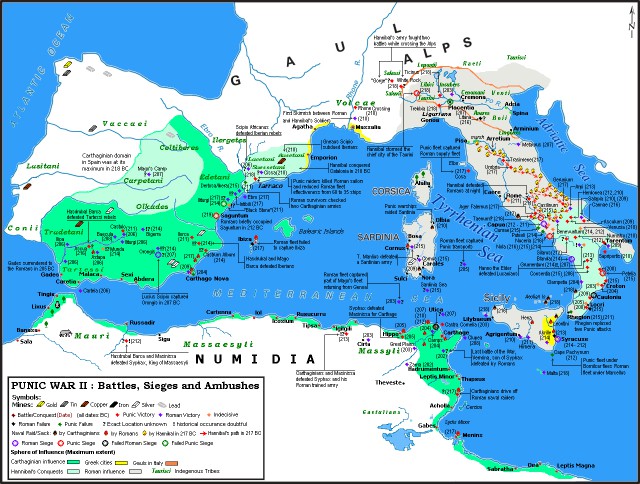
Scipio landed in Northern Africa in 204 BCE near Utica in modern Tunisia, north of Carthage with an army of about 28,000 men. Though Scipio hoped to take the city of Utica the siege was unsuccessful and Scipio was soon faced with a Carthaginian army that camped near to the Roman camp. Scipio sent spies into the camp and was able to organize a nighttime assault by starting the Carthaginian camp on fire and stationing his army around the exits to kill those who got out. Hardly even a fight, nearly 40,000 Carthaginians were killed with few casualties for the Romans. Though this was seen as a dishonorable move through most ancient wars, the second Punic War had dragged on for well over a decade with atrocities on all sides, so no tactic was off limits by this point.
Despite losing almost their entire army in the camp fires, The Carthaginian commander Hasdrubal and the Numidian Syphax were able to escape the camps and gather a surprisingly large army southwest of Utica. The Carthaginian numbers were bolstered by several thousand Celtiberian mercenaries who had just arrived. Within a month the Carthaginians had assembled an army larger than Scipio’s so Scipio was forced to attack them before they grew too large to confront.
At the battle of the Great Plains Scipio assembled his army in traditional maniple formation with young Hastati in the front, Principes in the middle and the most veteran Triarii in the rear and allies on the wings and cavalry on either flank. With this standard formation Scipio ordered a full attack against the Carthaginians who had placed the elite Celtiberians in the center and the remaining infantry on either wing and cavalry on the flanks.
Once engaged Scipio sent sections of his rear two lines around to flank the raw recruits that formed the Carthaginian wings. This extra push routed the wings and shortly after the Carthaginian cavalry broke leaving only the Celtiberians who fought incredibly valiantly but were surrounded and almost completely eliminated.
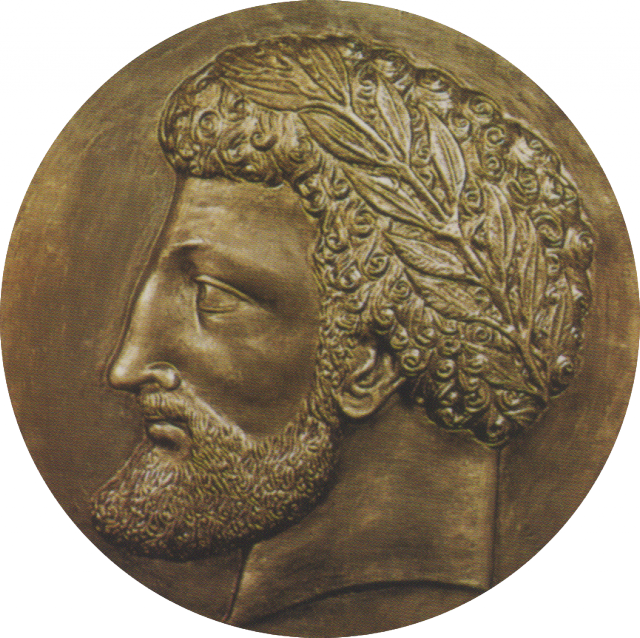
Hannibal, In Italy this whole time, was finally able to sail back to Africa. His holdings in Southern Italy had been steadily shrinking over the years and by the time he left he was only really in control of the “foot” of Italy. The arrival of Hannibal and his core of Italian veterans gave more hope to Carthage, who had kept both Carthage and Utica safe from Scipio. Even more mercenaries were hired and large amounts of Carthaginian citizens joined Hannibal’s army. Hannibal had the advantage in infantry at around 36,000 to Scipio’s 29,000 and initially had more cavalry at 4,000 but a last minute reinforcement by Masinissa brought Scipio’s cavalry to 6,000. Hannibal did have one more advantage, the massive stables of Carthage were emptied and 80 war elephants would form Hannibal’s front line.
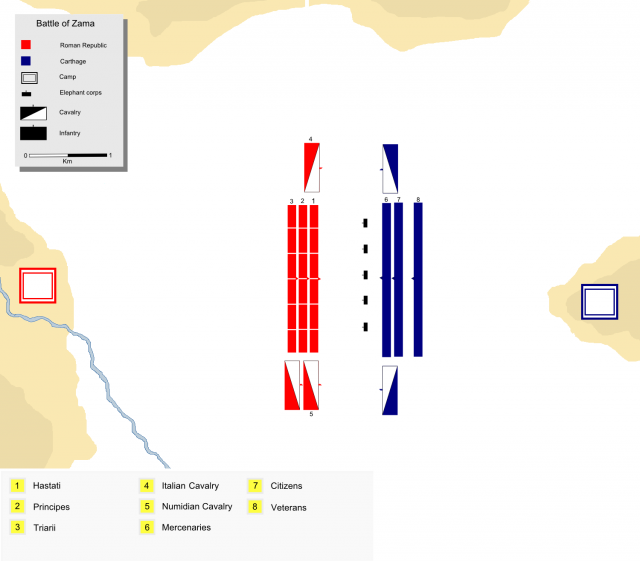
The battle of Zama was one of the most closely contested battles in antiquity between two of the greatest generals who ever lived. Scipio arranged his infantry not with each line staggered behind the other like the traditional checkerboard formation, but placed units of Principes and Triarii directly behind the Hastati creating several wide avenues from the front to the back of the formation. These gaps were filled by skirmishers, known as Velites, who could easily withdraw behind the Hastati. Like Hannibal did at Cannae Scipio took advantage of his more numerous cavalry by overloading one side. His right flank having Masinissa’s 4,000 cavalry and left with 2,000 Roman cavalry while Hannibal had 2,000 on either side. Hannibal had three lines of infantry and placed his Italian veterans in the rear line a greater than normal distance from the next line.
Seeing the disruption, Scipio’s cavalry advanced immediately. Both flanks of Hannibal’s cavalry were quickly routed and chased from the field. With all of the elephants and the cavalry gone the battle came down to the infantry. The first lines closed with young Hastati engaging the newly recruited mercenaries.
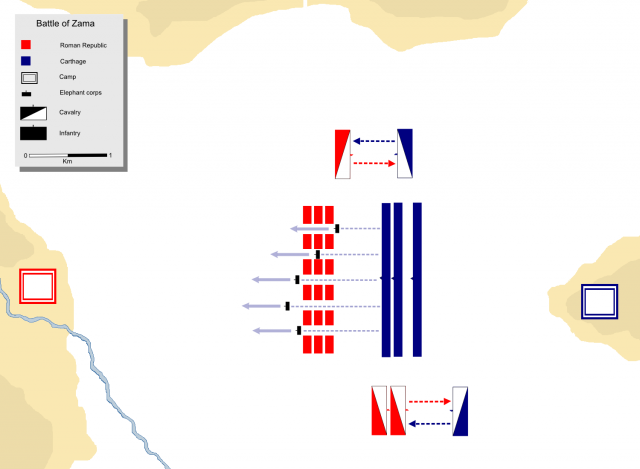
The Hastati were able to push back the first line and engaged with the second line of Carthaginian citizen soldiers who gave a fierce enough fight so that the Princepes seem to have been involved (sources are unclear). Soon enough the second line was broken, but Hannibal had accounted for this. In most battles these routed front lines would be out of the battle but Hannibal had organized it so that the third line was far enough back that the survivors could rally, and so the two lines took up positions on the flanks of the third line forming a long singular line that threatened to envelop Scipio’s more compact formation.
Scipio responded by marching his Princepes forward on either side of the Hastati and the Triarii on either side of them forming an equally long single line. Marching over the carnage of the earlier fighting the Romans charged. The disgraced survivors of Cannae sought redemption over the very same soldiers who had defeated them fourteen years earlier. The fighting was incredibly fierce with both sides refusing to give any ground.
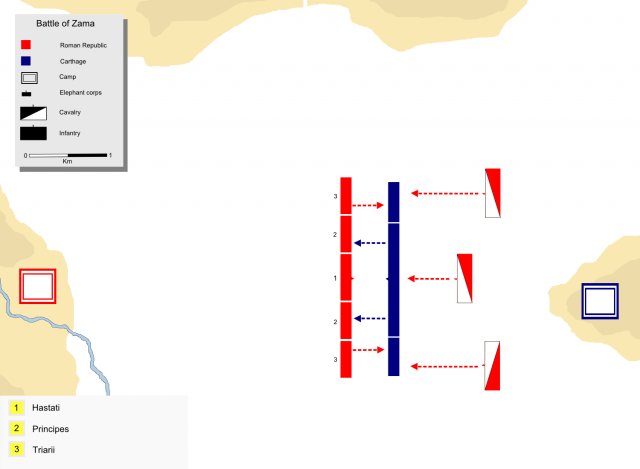
As the infantry were grinding away at each other Scipio’s victorious cavalry finally returned to the battlefield and charged the flanks of the Carthaginians. The mercenaries and citizens fled while the veterans mostly fought to the death. It was an absolutely brutal struggle that could have turned either way at any point. Getting victorious cavalry to return to battle was no easy task as most cavalry get too caught up in the chase or decide to loot the enemy camp. It is a credit to Masinissa and Laelius that they were able to return to achieve the victory
Rome had suffered three horrific defeats in their own territory and decided to fight on, for Carthage this, the third disaster in two years was enough for them to sue for peace and accept the crushing terms that would doom their empire and set them up for their eventual elimination.
Scipio was celebrated like no other upon his return to Rome. He was given meager forces in Spain and completely conquered that area. After fighting for permission to invade Africa, he won great victories, removed Hannibal from Italy where he had been for sixteen years and defeated him in open battle. He was the first Roman to be given a name for conquering an area, thereafter being known as Africanus. Hannibal gave his recommendation that Carthage surrender and soon fled Africa to seek service with foreign kings as he knew the Romans would seek personal revenge against him.

Δεν υπάρχουν σχόλια:
Δημοσίευση σχολίου